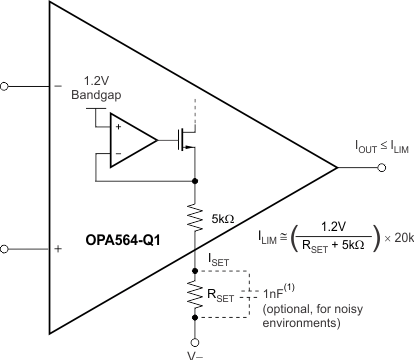SBOS567A June 2011 – February 2024 OPA564-Q1
PRODUCTION DATA
- 1
- 1 Features
- 2 Applications
- 3 Description
- 4 Device Comparison Table
- 5 Pin Configuration and Functions
- 6 Specifications
- 7 Detailed Description
- 8 Application and Implementation
- 9 Device and Documentation Support
- 10Revision History
- 11Mechanical, Packaging, and Orderable Information
Package Options
Refer to the PDF data sheet for device specific package drawings
Mechanical Data (Package|Pins)
- DWP|20
Thermal pad, mechanical data (Package|Pins)
- DWP|20
Orderable Information
7.3.1.1 Setting the Current Limit
Leaving the ISET pin unconnected damages the device. Connecting ISET directly to V– is not recommended because direct connection programs the current limit far beyond the 1.5A capability of the device and causes excess power dissipation. The minimum recommended value for RSET is 7.5kΩ, which programs the maximum current limit to approximately 1.9A. The maximum value for RSET is 55kΩ, which programs the minimum current limit to approximately 0.4A. The simplest method for adjusting the current limit (ILIM) uses a resistor or potentiometer connected between the ISET pin and V–, according to Equation 1.
If ILIM has been defined, solve for RSET by rearranging Equation 1 into Equation 3:
RSET in combination with a 5kΩ internal resistor determines the magnitude of a small current that sets the desired output current limit.
Figure 7-1 shows a simplified schematic of the OPA564-Q1 current limit architecture.
